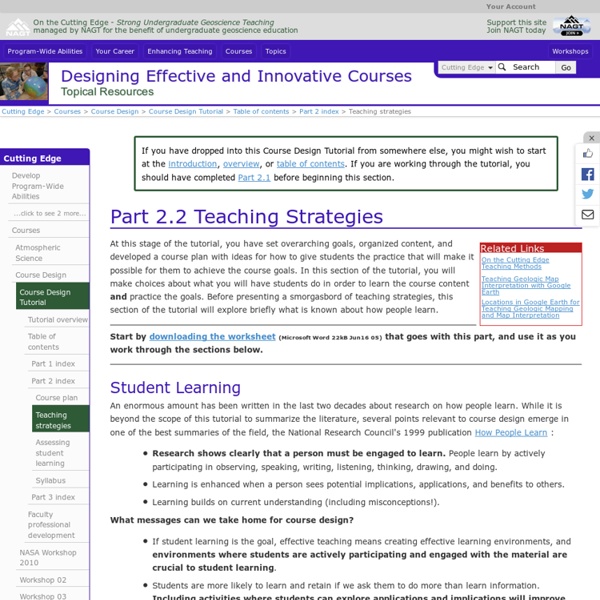Teaching strategies

http://serc.carleton.edu/NAGTWorkshops/coursedesign/tutorial/strategies.html
Related: Educational Websites
High School Teachers
High school teachers need to explain difficult concepts in terms students can understand. High school teachers must have a bachelor’s degree. In addition, public school teachers must have a state-issued certification or license. Education All states require public high school teachers to have at least a bachelor’s degree. Most states require high school teachers to have majored in a subject area, such as science or history.
DivCHED CCCE: Committee on Computers in Chemical Education
The Future of Case Study Teaching in Science By Clyde Freeman Herreid, University at Buffalo Paper 1: Download PDF Printable Version of Paper Abstract: Case study teaching in undergraduate science courses began 20 years ago. Today thousands of K-16 teachers are using the method and there are major websites that post hundreds of case studies and teaching notes in all STEM disciplines, especially the biological sciences. It is a puzzle why more chemists and other physical scientists have not embraced the method, since there is strong evidence that it is superior to the traditional lecture approach.
7 Things To Remember About Educational Feedback Infographic
Teacher Infographics At the 7 Things To Remember About Educational Feedback Infographic you will find 7 Educational Feedback Tips that will help Teachers give and receive effective classroom feedback. Feedback is not advice, praise or evaluation. Feedback is information about how we are doing in our efforts to reach a goal.If students know the classroom is a safe place to make mistakes, they are more likely to use feedback for learning.The feedback students give teachers can be more powerful than the feedback teachers give students.When we give a grade as a part of feedback, students often don’t see past the grade.Effective feedback occurs during the learning, when there is still time to act on it.Most of the feedback that students receive about their classroom work is from other students – and most of that feedback is wrong.Students need to know their learning target – the specific skill they’re supposed to learn – or else feedback is just someone telling them what to do.
LearningWorks for Kids
What is Working Memory? Working Memory is the thinking skill that focuses on memory-in-action: the ability to remember and use relevant information while in the middle of an activity. For example, a child is using their Working Memory as they recall the steps of a recipe while cooking a favorite meal.
Teaching Strategies
9. Be enthusiastic - you dont have to be an entertainer but you should be excited by your topic. (from Cashin, 1990, pp. 60-61) Case Method.
Case It Home Page - free molecular biology computer simulations simulation software
Case It! is a National Science Foundation - sponsored project which provides a framework for collaborative case-based learning via free, open-ended molecular biology simulations and cases based primarily on genetic and infectious disease . Case It v6.06 * is a simulation that performs common laboratory procedures on any DNA or protein sequence. It has all of the capabilities of the earlier version (6.05), but adds new features such as SNP and expression microarrays.
What Is Blended Learning? These Videos Will Get You Started
Blended learning is one of those buzz words in education and technology these days. It’s not bringing a blender to class and trying a ‘Will It Blend?’ type project. Sorry, had to include that joke. You’re better than that, though.
Overview of learning styles
Many people recognize that each person prefers different learning styles and techniques. Learning styles group common ways that people learn. Everyone has a mix of learning styles.
Co-Teaching Foundations
Co-Teaching is defined as two teachers (teacher candidate and cooperating teacher) working together with groups of students; sharing the planning, organization, delivery, and assessment of instruction, as well as the physical space. (Bacharach, Heck & Dank, 2004) The cooperating teacher (CT) is a classroom teacher who is willing to mentor the teacher candidate using co-teaching.
Related:



